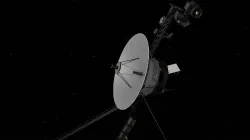NASA's 46-year-old spacecraft back online after going dark for months: Details here
This NASA space probe was launched in 1977 to explore the outer planets. It encountered a problem in November of last year, and the team identified the root cause of the problem in April of this year.

There is good news for all the space enthusiasts out there. NASA’s long-running Voyager 1 space probe is finally back online after seven months of technical difficulties. The space probe ran into problems in November 2023 when it started sending strange, unreadable data. The team has been working ever since to get to the root of the issue.
While the probe was receiving and executing commands without any problem. Its science and engineering data was not making any sense. In April, the team identified the problem as corrupted memory in the probe’s flight data subsystem (FDS) computer and later managed to restore functionality to two of its instruments, enabling them to send science data again.
For the unversed, in 1977, Voyager 1 and its twin, Voyager 2, were launched on a mission to explore the outer planets. Taking advantage of a unique planetary alignment, the probes visited Jupiter, Saturn, Uranus, and Neptune by using each planet's gravity to propel them to the next destination.
After completing its primary mission, Voyager 1 continued travelling toward the outer limits of the solar system. In 1990, it captured the iconic "pale blue dot" photo, showing Earth as a tiny speck in the vastness of space.
In 2012, Voyager 1 became the first human-made object to enter interstellar space. Both Voyager 1 and Voyager 2 have since been gathering valuable data about the heliosphere, the region of space influenced by the sun.
Each Voyager spacecraft carries a golden phonograph record containing sounds and images depicting life on Earth, intended to be discovered by potential extraterrestrial civilizations.
Meanwhile, NASA (National Aeronautics and Space Administration) accidentally broadcasted a simulation involving astronauts being treated for decompression sickness on the International Space Station (ISS), leading to widespread speculation on social media about a possible emergency on Wednesday.
ALSO READ: Aditya-L1’s instruments capture solar activity, monitor major solar flares